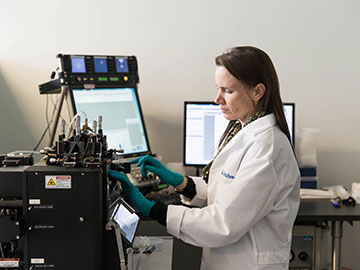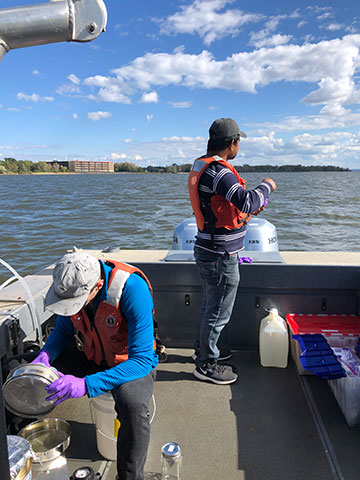
The flow cytometer from Bigelow Laboratory’s Center for Aquatic Cytometry, USA, run by senior research scientist Nicole Poulton, can be used to separate out and measure smaller microplastic particles. [Image: Greta Rybus]
Microplastics—small plastic particles less than 5 mm in diameter—have been found in everything from bodies of water and soil to air and even food. They have significant environmental impacts, and studies have demonstrated that exposure is harmful to organisms like fish and aquatic invertebrates.
Now, researchers at the University of Minnesota Duluth, USA, and Bigelow Laboratory for Ocean Sciences, USA have reportedly developed a novel method for identifying smaller varieties of microplastics (Limonl. Oceanogr. Meth., doi: 10.1002/lom3.10582). The approach involves first staining samples with a dye called Nile red, then combines flow cytometry and pyrolysis gas chromatography-mass spectrometry to both quantify and provide chemical characterization of microplastic samples.
Quantifying small microplastics
Microplastics range in size from the length of a grain of rice to a fraction of the width of a human hair. Current techniques for identifying them include Fourier transform infrared (FTIR) or Raman spectroscopy coupled with an optical microscope. However, FTIR analysis is limited to particles larger than roughly 10 to 20 µmand Raman analysis lacks scanning capabilities and is impacted by fluorescence from natural particles.
Flow cytometry, on the other hand, can identify and sort particles with a longest dimension of 0.2 to 100 µm. Recent work has coupled flow cytometry with Nile red fluorescent staining to provide rapid identification of plastic particles in water samples.

Researchers at the University of Minnesota Duluth, USA, collected water samples from the western arm of Lake Superior to test a new method for characterizing microplastics in aquatic systems. [Image: Elizabeth Minor]
“Small particles are important to quantify because these are the ones most likely to be ingested by aquatic organisms near the base of the food chain,” said study author Elizabeth Minor, a professor of chemistry and biochemistry at the University of Minnesota Duluth. “They are also the ones that can cross biological barriers in higher organisms like fish or mammals.”
However, none of these techniques has the ability to measure the mass of microplastics without making assumptions about particle shape and density. Properly assessing the toxicity and environmental impact of these particles depends on knowing both count and mass.
A combination of techniques
Minor and her colleagues decided to integrate several approaches that have previously been used individually for microplastics but not together on a single sample. First, surface water samples undergo size-fractionated filtration with metal sieves (300 μm, 106 μm, 45 μm, 5 μm). Oxidization and density separation remove sand, clay and other natural particles. Then, Nile red staining allows for microplastic detection based on relative green fluorescence after excitation with a blue (488 nm) laser.
Using size criteria determined for forward scatter using calibration beads and green fluorescence to indicate plastics, the particles are physically sorted with flow cytometry. These sorted microplastics are then concentrated by centrifuge filtration, dried and analyzed by pyrolysis gas chromatography-mass spectrometry.
This method allowed for the measurement of smaller microplastics ranging from 5 to 45 μm in diameter, both in terms of particle counts and the mass of a particular polymer in the sample. Minor and her colleagues tested the technique with surface water from Lake Superior, finding particle abundances two to three orders of magnitude higher than larger particles (> 100 μm) measured with FTIR microscopy.
“Now that we know how to do this and how many particles are necessary to achieve appropriate signal-to-noise ratios, the next step would be to apply this approach to other aquatic locations in oceans and lakes throughout the world,” said Minor.

